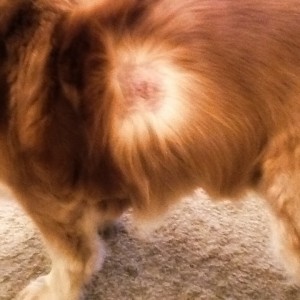 Courtesy of Rosalind R.
Through i Love Dogs (iLD) premium canine supplements I'm able to reach pet owners worldwide to answer their questions through the iLD Ask A Vet webpage. This post originally appeared on i Love Dogs as: Could the Sore on My Dog Be Related to Her Mobility Issues?
Courtesy of Rosalind R.
Through i Love Dogs (iLD) premium canine supplements I'm able to reach pet owners worldwide to answer their questions through the iLD Ask A Vet webpage. This post originally appeared on i Love Dogs as: Could the Sore on My Dog Be Related to Her Mobility Issues?
I just found a round wound matted with blood on my dog Shadow. I cut away all the hair and found a large boil-like substance that is quite flat, white and circular with a diameter of about 5 centimeters. It looks like it has burst in two places and blood has been coming out of it. It doesn’t seem to be bothering her, but I’m quite concerned about it.
I know she hasn’t been in a fight or anything, but she does have problems with her right back leg. Since she’s 13, I thought that was most likely related to old age and perhaps some arthritis, but now I’m wondering if the sore could be related? She does favor the leg, and seems to tire quickly. My vet put just her on a diet and gave her pain killers for her stiffness.
I did ask him about a lump that was there at the time, but he told me not to worry about it. I can’t recall whether this sore is in the same place as the lump. He did tell me that she may be too old to undergo X-rays to get more information about her hindquarters, as her heart may not be able to handle going under. Do you have any ideas?
–Rosalind
Hi Rosalind,
Thank you for your question.
There are a variety of underlying reasons that could potentially cause the appearance of Shadow’s skin as you describe and photo-document, including:
- Infection–bacteria, yeast, parasites, virus, etc.
- Inflammation–seasonal or nonseasonal environmental allergens, hypersensitivity reaction (to an insect sting or bite, for example), food allergy, etc.
- Trauma–penetrating injury from a stationary environmental object, bite from another animal, exposure to an irritating substance, etc.
- Cancer
